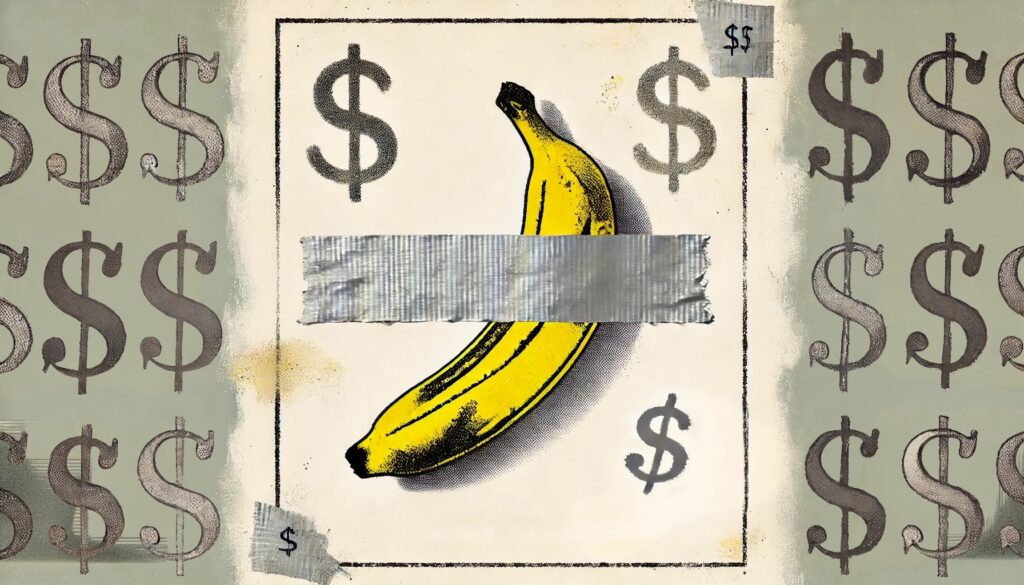The $6 Million Banana: What It Says About Art, Wealth, and Opportunity
How Maurizio Cattelan’s $6.24 million duct-taped banana reveals deeper truths about the intersection of art, wealth, and absurdity.

Maurizio Cattelan’s duct-taped banana—titled Comedian—rocketed to fame once again on November 20, 2024, when it sold for $6.24 million at Sotheby’s. Originally debuting at Art Basel Miami Beach in 2019, where it sold for $120,000, the artwork has become a symbol of both absurdist art’s daring creativity and its unapologetic commercialization. But beyond the spectacle, what does this mean for the broader art world, especially for Black artists navigating these same markets?
Art as a Playground for the Wealthy Elite
Let’s address the elephant—or rather, the banana—in the room. How does a $0.25 fruit with a piece of tape sell for over $6 million? The art market, worth $65 billion globally as of 2023, has long been a space where price tags reflect the whims of wealth rather than intrinsic value. This sale amplifies that trend, transforming art into a tool of spectacle for the elite. For many, Cattelan’s success symbolizes art as a playground for the super-rich, where financial clout overshadows cultural contribution.
For artists who dedicate years to mastering their craft, this spectacle can be disheartening. Imagine pouring your soul into a canvas, only to see a banana grab global headlines. It begs the question: Why should artists aspire to works that cater to spectacle rather than meaning?
Why Not Take Art Less Seriously?
On the flip side, Comedian is an intentional challenge to art’s seriousness. Cattelan has described the work as an “invitation to rediscover the power of irony and simplicity.” Viewed this way, it’s less about the banana itself and more about how we respond to it. The piece’s global fame may nudge artists to loosen up and embrace ideas they genuinely enjoy, rather than sticking to what’s traditionally respected—or commercially viable.
But comparison is the thief of joy, and many might wonder: Should the goal even be to sell a banana for $6 million? Instead of aspiring to follow Cattelan’s path, artists could question the structures that make such sales possible and build creative paths with deeper cultural impact.
What This Means for Black Artists
For Black artists, this sale raises complicated questions. While Comedian proves that there’s money and media attention available for even the most unconventional works, how realistic is this for Black artists? Would the same art world that celebrates a duct-taped banana extend the same enthusiasm for conceptual works by a Black artist?
Historically, Black artists have been held to higher standards, often judged more harshly in markets and media circles. Even today, the contemporary art market skews heavily toward white artists. Between 2021 and 2022, Contemporary Art sales globally reached $2.7 billion, but Black artists remain underrepresented among top sellers. While artists like Jean-Michel Basquiat broke barriers with multi-million-dollar sales, such moments remain exceptions rather than the norm.
Still, there’s room for optimism. Artists like David Hammons, known for his conceptual and often playful works, have been critical of art world hypocrisy while simultaneously navigating its high-value pricing structures. Media platforms and institutions dedicated to Black art are working to lower these barriers, expanding visibility for Black artists whose works might otherwise go unnoticed. Greater representation in media and exhibitions could help redefine success for Black artists beyond the commercial frameworks that dominate today.
Who Really Benefits?
Sensationalism sells, and nowhere is that clearer than in the art market. Media coverage of Cattelan’s banana amplified its value, driving bidding wars and cementing its place in cultural history. But this reliance on spectacle raises questions about who truly benefits.
At the heart of sales like this are questions of power. While Cattelan pocketed millions and Sotheby’s reaped the rewards of media frenzy, it’s worth asking if these moments benefit the broader art community. High-profile sales elevate collectors’ portfolios and pad auction house profits, but do they translate to systemic change for working artists?
The Future of Art
The $6 million banana is a moment of reflection for the art world. It forces us to confront what we value—and why. For some, it’s a wake-up call to embrace freedom and humor in art. For others, it’s a symbol of the inequality and spectacle that define the modern market.
For Black artists, it highlights both the possibilities and the persistent inequities in a world where media, wealth, and perception dictate success. As we celebrate those who break through, we must also challenge the systems that make such breakthroughs so rare.
Ultimately, the value of art lies not in its price but in its power to connect, inspire, and provoke. And in that sense, maybe a banana taped to a wall is worth more than it seems.
Sources: ArtNews, Sotheby’s, ArtPrice, Artsy, The Art Basel and UBS Global Art Market Report 2024
 The African American Museum in Dallas Marks 50 Years with Founders Ball
The African American Museum in Dallas Marks 50 Years with Founders Ball Koyo Kouoh’s Appointment as 2026 Venice Biennale Curator
Koyo Kouoh’s Appointment as 2026 Venice Biennale Curator Black Art at Miami Art Week 2024: History, Events, and Cultural Impact
Black Art at Miami Art Week 2024: History, Events, and Cultural Impact Reclaiming Ancient Egypt: Dream or Distraction for Black Art?
Reclaiming Ancient Egypt: Dream or Distraction for Black Art? Smithsonian’s National Museum of African Art Appoints New Leadership
Smithsonian’s National Museum of African Art Appoints New Leadership

